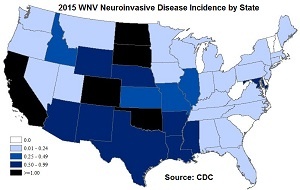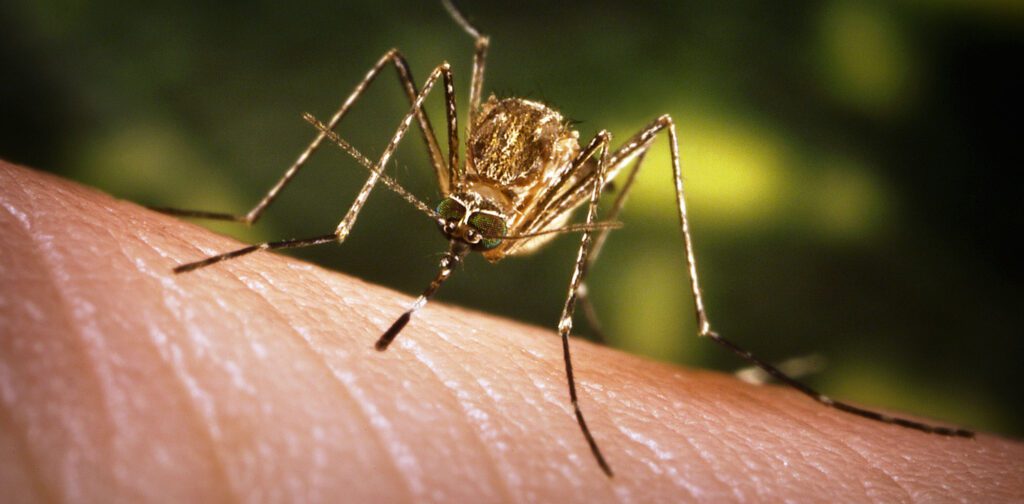Mosquito-Borne Diseases In the U.S. in 2015
In 2015, we saw a continuation of serious mosquito-borne disease cases in the United States. This blog covers three of many diseases that were transmitted by mosquitoes in 2015: West Nile Virus (WNV), Eastern equine encephalitis (EEE), and chikungunya. These three represent the most common mosquito-borne diseases we find in the United States, with WNV being far and away from the most common threat in U.S. territories. All of the information in this year’s review post was taken from the Center for Disease Control (CDC)’s data points and website as of 12/31/2015.

West Nile Virus (WNV):
WNV is the most common virus transmitted by mosquitoes to humans in the United States. While most infected people will have no symptoms, roughly one in five will develop symptoms that may include a combination of fever, headache, body aches, skin rash, or swollen lymph nodes. Other symptoms may include a stiff neck, sleepiness, disorientation, or even paralysis.
In 2015, 48 out of 50 states reported WNV infections in people, mosquitoes, or birds. In those states, 2,060 cases of WNV were reported in humans, and there were 119 confirmed deaths (5.8%) in 2015. This is in line with 2014 data, which had 2,205 human cases of WNV and 97 deaths (4.4%). Keep an eye out for a future blog post with much greater detail about WNV and its effect on humans, as well as on bird populations.
Eastern equine encephalitis (EEE):
EEE is also transmitted to humans by the bite of an infected mosquito, but is, fortunately, a rare illness for humans, with only a few cases reported in the United States each year. Although some people infected with EEE have no apparent illness, severe cases of EEE lead to inflammation of the brain, often beginning with a high fever, headaches, and vomiting. The illness will often progress into disorientation, seizures, or coma. EEE is a severe mosquito-transmitted disease, with about a 33% mortality rate. Additionally, even survivors can develop significant brain damage.

As of Nov. 17, the CDC reported five cases of EEE nationally in 2015: one in Louisiana, one in Maine, and three in New York. The Maine case and two of the New York cases were fatal. An average of eight EEE cases is reported each year in the United States, with 15 cases in 2012 and 8 cases in 2013 (2014 statistics presently unavailable). Keep an eye out for a future blog post with much greater detail about EEE and the many ways in which Vector Disease Control International (VDCI) helps prevent the spread of this deadly disease.
Chikungunya:
Traditionally, chikungunya outbreaks have occurred in countries in Africa, Asia, Europe, and the Indian and Pacific Oceans. Since 2013, chikungunya has been found in the Americas on islands in the Caribbean. Since then, about 1.5 million cases have been reported in the Americas. Symptoms are most often a high fever and joint pain. Other symptoms may include muscle pain, joint swelling, and headaches. Joint pain can often be debilitating, but thankfully, chikungunya is rarely fatal. Mosquitoes become infected when they bite someone already infected with the virus, and then infected mosquitoes spread the virus to other people they bite.
In 2015, 679 chikungunya virus disease cases were reported in 44 states. All reported cases occurred in travelers returning from affected areas, and importantly, no locally-transmitted cases have yet been reported from U.S. states in 2015. In 2014, a total of 2,811 chikungunya virus cases were reported from U.S. states, with twelve locally transmitted cases being reported from Florida. All other cases occurred in travelers returning from affected areas. Stay tuned for a future blog post with much greater detail about chikungunya and the ways VDCI helps prevent the spread of this potentially debilitating disease.
Zika:
Zika appears to be a growing threat for U.S. citizens traveling to South America and possibly Florida. Therefore, stay tuned for more information on that virus in the coming months.
Contact Us to Learn More About Effective Mosquito Management Strategies:
 Since 1992, Vector Disease Control International (VDCI) has taken pride in providing municipalities, mosquito abatement districts, industrial sites, planned communities, homeowners associations, and golf courses with the tools they need to run effective mosquito control programs. We are determined to protect the public health of the communities in which we operate. Our mosquito control professionals have over 100 years of combined experience in the field of public health, specifically vector disease control. We strive to provide the most effective and scientifically sound mosquito surveillance and control programs possible based on an Integrated Mosquito Management approach recommended by the American Mosquito Control Association (AMCA) and Centers for Disease Control and Prevention (CDC). VDCI is the only company in the country that can manage all aspects of an integrated mosquito management program, from surveillance to disease testing to aerial application in emergency situations.
Since 1992, Vector Disease Control International (VDCI) has taken pride in providing municipalities, mosquito abatement districts, industrial sites, planned communities, homeowners associations, and golf courses with the tools they need to run effective mosquito control programs. We are determined to protect the public health of the communities in which we operate. Our mosquito control professionals have over 100 years of combined experience in the field of public health, specifically vector disease control. We strive to provide the most effective and scientifically sound mosquito surveillance and control programs possible based on an Integrated Mosquito Management approach recommended by the American Mosquito Control Association (AMCA) and Centers for Disease Control and Prevention (CDC). VDCI is the only company in the country that can manage all aspects of an integrated mosquito management program, from surveillance to disease testing to aerial application in emergency situations.

